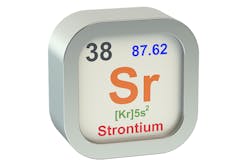What is it?
- Strontium is a silvery alkaline earth metal with chemistry similar to calcium and magnesium.
- It is a minor contributor to hard water.
- It forms water soluble Sr++ salts, such as strontium chloride (SrCl2).
- The U.S. Environmental Protection Agency (EPA) announced its intention to regulate strontium in drinking water in October 2014.
Occurrence
- Strontium was found in more than 99 percent of 989 groundwaters in the 1988 National Inorganics Reconnaissance Survey (NIRS). Concentrations ranged from 1 part per billion (ppb) to greater than 10 parts per million (ppm) with a mean of 0.6 ppm (600 ppb). Seven percent of NIRS groundwaters exceeded 1,500 ppb.
- The third Unregulated Contaminants Monitoring Rule reports 100 percent detections.
- Dietary exposure estimates are approximately 2 to 4 milligrams per day (mg/day).
Health effects
- Because strontium and calcium’s chemistries are similar, strontium can accumulate in bone and affect bone formation at sufficiently high doses. However, calcium’s daily exposure far exceeds strontium’s. Calcium’s recommended daily allowance is greater than 1,000 mg/day.
- The EPA’s original Drinking Water Health Advisory and Health Reference Level (HRL) were 4,000 ppb. These were changed to 1,500 ppb in the October 2014 preliminary regulatory determination by choosing a different rat study and raising the uncertainty (safety) factor from 300 to 1,000. The latter alone reduces the HRL by a factor of 3.3. Strontium is not highly toxic. However, concerns exist regarding excess exposure in the early bone forming years.
- Strontium-based drugs (ranelate) are used in osteoporosis treatments, and strontium compounds are also available as over-the-counter supplements. It is also a tooth enamel strengthener in some toothpastes.
Water treatment
- Water softening is an effective treatment for strontium, and it is probably present in small relative amounts in many hard waters.
- Municipal water plants use precipitative lime softening with calcium hydroxide and lime-soda ash softening.
- Point-of-entry softening with a cation exchange resin is a common practice.
- Point-of-use reverse osmosis softening is another option in the home.
Regulation
- The regulatory impact would be significant because of impacts in small water systems.
- In January 2016, the EPA announced a delay in making a final regulatory determination in response to negative public comments.
- Negative comments to the October 2014 notice addressed whether a regulation could be justified under the Safe Drinking Water Act specifications, high costs and likely small benefits, energy consumption, uncertainties in the health risk assessment, and recommended epidemiology studies to examine EPA’s assumptions of human risks that were extrapolated from rat data.
- The EPA stated that it would reevaluate its 20 percent relative source contribution (RSC) default value. This is important, because the greater the RSC, the greater the maximum contaminant level.
- The EPA also stated that it does not plan to conduct epidemiology studies but would conduct water treatment studies.
- The EPA’s position is puzzling since water softening treatment is well understood and widely practiced, but the uncertainties are in the health basis for a regulation.
- Monitoring requirements would affect all community water systems.
- Some well designed epidemiology studies would appear to be good policy prior to a regulation that would impact many water supplies and include high costs. The purported health effects would be readily detectable and quantified with dose response measurements with non-invasive studies in a few communities.
- Expect that the decision process will add at least a year.
- Perhaps prematurely, New Jersey issued a groundwater quality standard of 1,500 ppb in October 2015, using the EPA’s 2014 notice as the basis.
Read Dr. Cotruvo’s previous article on strontium.
Dr. Joe Cotruvo is president of Joseph Cotruvo and Associates, LLC, Water, Environment and Public Health Consultants. He is a former director of the EPA Drinking Water Standards Division.


